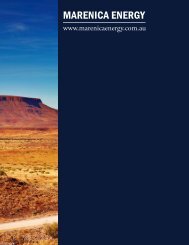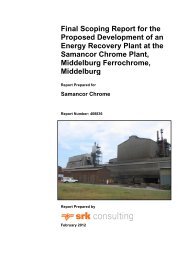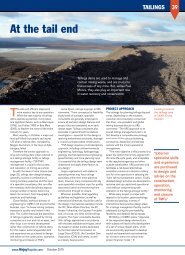Draft Status Quo Report for the Pixley Ka Seme ... - SRK Consulting
Draft Status Quo Report for the Pixley Ka Seme ... - SRK Consulting
Draft Status Quo Report for the Pixley Ka Seme ... - SRK Consulting
Create successful ePaper yourself
Turn your PDF publications into a flip-book with our unique Google optimized e-Paper software.
<strong>SRK</strong> <strong>Consulting</strong> in association with BKS<br />
<strong>Pixley</strong> <strong>Ka</strong> <strong>Seme</strong> Local Municipality EMF – <strong>Draft</strong> <strong>Status</strong> <strong>Quo</strong> <strong>Report</strong> Page 24<br />
O<strong>the</strong>r mining<br />
The geological materials present in PKSLM are not<br />
considered to be that favourable <strong>for</strong> exploitation as<br />
construction materials. However <strong>the</strong>re is some sand and<br />
aggregate mining in <strong>the</strong> nor<strong>the</strong>rn and north eastern parts<br />
of <strong>the</strong> study area, and rock quarrying in <strong>the</strong> central parts<br />
(see Map 32).<br />
3.2.6 Water resources<br />
Surface water quantity<br />
The PKSLM is situated in <strong>the</strong> headwaters of three<br />
major rivers and Water Management Areas (WMAs),<br />
namely <strong>the</strong> Upper Vaal, Thukela and Usutu to Mhlatuze<br />
(see Map 12 <strong>for</strong> WMAs and major surface water<br />
sources, and Section 3.2.7 <strong>for</strong> in<strong>for</strong>mation on <strong>the</strong><br />
numerous wetlands in PKSLM). The bulk of <strong>the</strong> study<br />
area falls in <strong>the</strong> Upper Vaal WMA, while <strong>the</strong> eastern<br />
portion falls in Usutu to Mhlatuze WMA and <strong>the</strong> sou<strong>the</strong>astern<br />
portion lies in <strong>the</strong> Thukela WMA (in Van<br />
Niekerk et al., 2010).<br />
PKSLM totally and/or partially contains 14 quaternary<br />
catchments (see Table 3-1). The portion of <strong>the</strong> Upper<br />
Vaal WMA that falls within <strong>the</strong> PKSLM comprises<br />
tertiary catchments C11 and C13. The C11 catchment is<br />
upstream of Grootdraai Dam and C13 comprises <strong>the</strong><br />
Klip River that joins <strong>the</strong> Vaal River downstream of<br />
Grootdraai Dam. The Usutu WMA comprises <strong>the</strong><br />
Assegaai and Hlelelo Rivers as well as <strong>the</strong> Heyshope<br />
Dam in <strong>the</strong> tertiary catchment W51. The portion of <strong>the</strong><br />
PKSLM which falls within <strong>the</strong> Thukela WMA, includes<br />
<strong>the</strong> towns Wakkerstroom and Volksrust in tertiary<br />
catchment V31 upstream of Zaaihoek Dam in <strong>the</strong> Slang<br />
River, a tributary of <strong>the</strong> Buffalo River.<br />
Quaternary<br />
Catchment<br />
Table 3-1: Details of <strong>the</strong> 14 Quaternary<br />
Catchments in <strong>the</strong> study area<br />
Combined<br />
Catchment area Forestry Alien veg. Irrigated minor dams MAE MAP<br />
Gross Net area area area area volume<br />
(km 2 ) (km 2 ) (km 2 ) (km 2 ) (km 2 ) (km 2 ) (mcm) (mm) (mm)<br />
C11B 536 536 0.00 0.00 0.83 0.49 1.61 1,400 705<br />
C11C 450 450 0.00 0.00 0.71 0.10 0.38 1,400 765<br />
C11D 373 373 0.00 0.00 0.59 0.69 1.54 1,400 702<br />
C11E 1,157 1,157 0.00 0.00 1.78 0.81 1.31 1,400 697<br />
C11J 1,002 1,002 0.00 0.00 1.54 0.19 0.29 1,450 658<br />
C11L 948 948 0.00 0.00 1.48 0.61 1.63 1,450 675<br />
C13A 595 595 0.00 0.00 0.57 0.09 0.20 1,400 779<br />
C13B 616 616 0.00 0.00 0.71 0.00 0.00 1,400 683<br />
C13D 896 896 0.00 0.00 0.99 0.00 0.00 1,400 698<br />
V31A 622 622 0.00 1.70 4.42 0.02 0.30 1,400 916<br />
V31B 505 505 20.40 21.80 5.18 0.51 2.10 1,400 856<br />
W42C 377 377 10.40 1.10 0.00 0.00 0.00 1,400 1,017<br />
Source: WRC (2008)<br />
The accumulated stream flow varies greatly from a high<br />
264 mm in <strong>the</strong> east upstream of Heyshope Dam to a low<br />
57 mm in <strong>the</strong> west.<br />
The Upper Usutu to Mhlatuze WMA in PKSLM<br />
including <strong>the</strong> Zaaihoek Dam is already highly<br />
developed and cannot sustain additional water use.<br />
Water transfers to <strong>the</strong> Upper Vaal and Olifants WMA,<br />
and af<strong>for</strong>estation account <strong>for</strong> <strong>the</strong> bulk of available<br />
water.<br />
The Upper Vaal WMA receives <strong>the</strong> bulk of available<br />
water by relatively high quality water transfers from <strong>the</strong><br />
Upper Usutu to Mhlatuze. There is a large projected<br />
growth in demand in <strong>the</strong> WMA as a whole, but also <strong>for</strong><br />
additional requirements in its upper reaches <strong>for</strong> petrochemical<br />
industries and power generation.<br />
The Thukela WMA is <strong>the</strong> source of water <strong>for</strong> <strong>the</strong><br />
Thukela-Vaal Transfer Scheme which, inter alia,<br />
transfers water from <strong>the</strong> Thukela River catchment to <strong>the</strong><br />
Sterkfontein Dam in <strong>the</strong> Vaal River system.<br />
International obligations govern <strong>the</strong> supply of water to<br />
neighbouring countries of Namibia, Swaziland and<br />
Mozambique situated downstream of <strong>the</strong> three WMAs<br />
whose headwaters fall in <strong>the</strong> study area.<br />
Surface water quality<br />
The overall quality of <strong>the</strong> rivers in <strong>the</strong> region is<br />
acceptable. Besides mining activities in <strong>the</strong> PKSLM,<br />
discharge from <strong>the</strong> various Waste Water Treatment<br />
Works (WWTW) pose a potential threat to <strong>the</strong> water<br />
quality in <strong>the</strong> rivers (see Section 3.3.2). Surface water<br />
quality in <strong>the</strong> PKSLM is indicated in Map 13, and can<br />
generally be described as follows (in Van Niekerk et<br />
al., 2010):<br />
• Water resources in <strong>the</strong> vicinity of major centres<br />
have poorer water quality than outlying areas<br />
mainly due to effluent outflow from WWTW<br />
battling with under-capacity and maintenance;<br />
• Total Dissolved Solids (TDS) concentrations are<br />
below 270 mg/l or 30 mS/m, and are thus<br />
acceptable <strong>for</strong> drinking water;<br />
• Calcium sulphate salts are dominant in <strong>the</strong> rivers,<br />
indicating water quality influences from acid mine<br />
wastes and many o<strong>the</strong>r industrial processes such as<br />
tanneries, textile mills and processes using<br />
sulphuric acid or sulphates. Atmospheric sulphur<br />
KILI/BEAT G:\404946_PIXLEY EMF\7REPORTS\<strong>Status</strong> <strong>Quo</strong> report\<strong>Draft</strong> report\<strong>Draft</strong> status quo report, July 2010.docx July 2010









